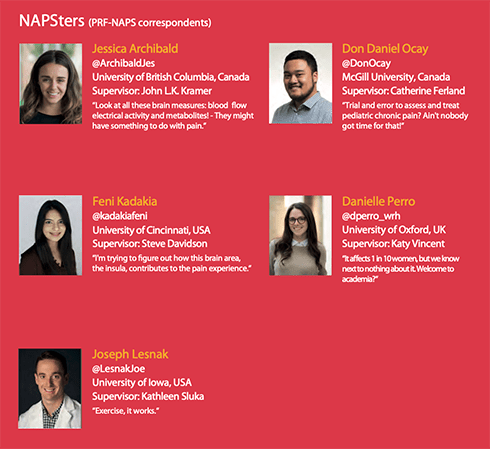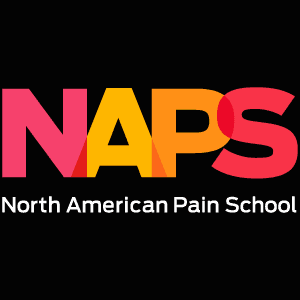Five early-career pain researchers are participating in the PRF-NAPS Correspondents program during the 2022 North American Pain School, taking place 19-24 June in Montebello, Québec City, Canada. The Correspondents program is a unique science communication training program that provides participants with knowledge and skills needed to communicate science effectively to a wide range of pain researchers, patients, and the greater public. The Correspondents will conduct interviews with NAPS Visiting Faculty and Patient Partners, write summaries of scientific lectures – and provide live blogging, too! Take a look at their blog posts below from day 3 at NAPS.
NAPS Blog Posts: Day 3
At NAPS, We Have Been Filling the GAPS
Controversy and PowerPoint: An Interactive Day of Science Communication
At NAPS, We Have Been Filling the GAPS
As a scientist, you receive specialized training in many subjects. You spend years learning the details and methods of your field, and dip into other sub-disciplines. You learn about research methods, how to design and interpret experiments. You will dive deep into statistics to perform the appropriate testing and modeling of your results. When reporting, you learn about data visualization, which requires programming skills and graphic design. You will also spend endless hours improving your writing skills.
Among all this training, some essential skills can slip through the cracks. At NAPS, we have been filling in the gaps. We learned about philanthropic funding opportunities, and how our communication approach shifts depending on our audience. We’ve had hands-on experience pitching and financing a scientific idea (@UTDPainLab). Jennifer Haythornthwaite opened our eyes to the intricacies of mentorship. Jeff Mogil broke down how we can prepare engaging talks (@JeffreyMogil).
When I think about science, I think about the systematic study of the world through observation and experiment. I think about pure intention, someone who is wanting to better understand. When I see scientists all around me, I see these characteristics, as well as the practice, the education, the development, and connections that shape us.
Jessica Archibald is a PhD candidate at the University of British Columbia, Canada. You can follow her on Twitter – @ArchibaldJes
Day 3 of NAPS was fantastic. We had an impactful presentation from Kathleen Sluka on the importance of utilizing female experimental subjects in basic science research, and in the afternoon Yenisel Cruz-Almeida, PhD (University of Florida, US), led an interactive workshop on the use of quantitative sensory testing in the clinical population. We finished the night with a group workshop led by Jeff Mogil on improving scientific presentations.
However, my favorite workshop of the day was presented by Greg Carbonetti, PhD (International Association for the Study of Pain), our PRF-NAPS Correspondent leader. I believe it’s important that scientists improve their ability to present and disseminate research to a lay audience. I decided to join this Correspondents program to work on these skills. In our increasingly digital- and social media-driven world, it’s important that research scientists learn how to share and communicate effectively about their research on these platforms.
Greg led a great discussion on how scientists can improve their scientific writing and presentations by reducing jargon and getting to the point. He challenged us to be able to describe our thesis in five seconds or less, which was very challenging and led to some great laughs. Scientific communication is a skill we all need to strengthen, and I am excited to work toward that goal.
Joseph Lesnak, DPT, is a PhD candidate at the University of Iowa, US. You can follow him on Twitter – @LesnakJoe.
We’ve heard of explaining your research in 180 seconds. Have any of you tried explaining your research in five seconds? Greg Carbonetti, the senior manager of the Pain Research Forum, told NAPSters to get to the point.
Three amazing NAPSters (@leahthePhDya, @tylernelson406, and @scottravyts) were challenged with the difficult task of explaining their thesis research in 5 seconds. How would you approach it? NAPSters were also asked to summarize their research in one sentence on Twitter. This is hard. As researchers, we have a responsibility to be able to share our projects with the general public, because grant funding comes from tax dollars. They pay us to have our research conducted, published, and shared.
So how do you write and talk about your research? First, know your audience! Who are you talking to? “If you are giving a talk to impress an expert in the field, you are doing it wrong” – @JeffreyMogil. Second, practice! Get in front of a mirror and talk. Notice your tone and your body language. Finally, you need to ACTIVELY LISTEN. There is a difference between talking and having a conversation.
Don Daniel Ocay is a PhD candidate at McGill University, Montreal, Canada. You can follow him on Twitter – @DonOcay
Controversy and PowerPoint: An Interactive Day of Science Communication
As a science communicator, I was really excited for today’s session run by Greg Carbonetti (@PainResForum). While I think about the main messages of my thesis often, I’ve never had to explain them in 5 seconds. Kudos to everyone who stood in front of us and described their work!
Today was interactive. We played with props, acted, and became pseudo-sports journalists. Thanks to Greg, we thought about how we communicate our science. One important takeaway from this session was to avoid jargon. We use jargon routinely in our daily conversations and our emails. Unfortunately, as scientists we often use jargon to disseminate knowledge.
How tempting is it to add more descriptive words to your sentences? I’m a sucker for the “great” and “incredible” interjection, but this isn’t how you get your message across (not as effectively, anyway). We need to consider our audience, who we are writing for, and whether we are using appropriate language for that audience, without patronizing.
I appreciated today’s sessions, the progression of NAPS, and our collective ability to have constructive conversations (especially about controversies). Among the trainees, early-career researchers, Patient Partners, and Visiting Faculty, we’ve engaged in difficult conversations that haven’t felt possible in this era of Zoom calls – not in the fashion that was as respectful, explorative, and motivating as today at least. How often can you have people yelling ideas across a room about the ideal PowerPoint template, design, and presentation style?
Our evening session reminded me of an important aspect of being a researcher – we must be able to share new ideas and challenge the ideas of others. This is a skill I’m still working on, but seeing how it worked practically today was remarkable. I can’t wait to see what’s in store for the IASP World Congress on Pain in Toronto!
Danielle Perro is a fourth-year PhD candidate at the University of Oxford, UK. You can follow her on Twitter – @dperro_wrh
Now that all of our student talks are complete (which were fantastic), our day at NAPS comprised more workshops and Visiting Faculty talks. Kathleen Sluka gave a presentation titled, “Why Does Sex Matter in Pain Research?” She provided some shocking statistics that demonstrate the disparity in use of both male and female subjects in science, especially in the context of animal studies. There’s actually an order of magnitude difference in the number of human studies versus animal studies that use both sexes! Basic science researchers can do better. The excuse, “Find an effect in males first,” isn’t going to cut it!
We also had a fun, interactive workshop with Greg Carbonetti who talked about how to better communicate our research. Two things that stuck out to me:
1. We don’t need to “dumb it down.” Now that I think of it, I hate that phrase. What it actually comes down to is understanding your audience and your key message.
2. Effective communication is bidirectional. It’s important to be an active listener! There was also a small debate about whether science communication should be a course requirement. A fellow NAPSter offered, “As scientists, it is a disservice to ourselves, to patients, and to taxpayers if we don’t learn how to effectively communicate our research.”
The highlight of my day was the workshop hosted by Yenisel Cruz-Almeida on pain testing in humans. We applied topical capsaicin to our arms and performed quantitative sensory testing. I got to experience thermal hyperalgesia, conditioned pain modulation, and distraction analgesia. It was fascinating to see these different pain modulatory experiences I’ve studied in mice on myself!
Feni Kadakia is a PhD student at the University of Cincinnati, Ohio, US. You can follow her on Twitter – @KadakiaFeni
The 2022 PRF-NAPS Correspondents




